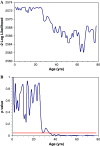Age as a prognostic factor for patients with osteosarcoma: an analysis of 438 patients
- PMID: 19784847
- PMCID: PMC11828252
- DOI: 10.1007/s00432-009-0690-5
Age as a prognostic factor for patients with osteosarcoma: an analysis of 438 patients
Abstract
Background: It is unclear whether age at diagnosis is an important prognostic factor in patients with osteosarcoma. Understanding this relationship could yield valuable insight into therapeutic rationale, focus patient selection for clinical trials, advance molecular concepts and theories, and expand current principles guiding prognosis. Our aim was to understand if age at diagnosis is a prognostic indicator for eventual outcome, as measured by disease-free survival and overall survival in patients with osteosarcoma.
Methods: Our cohort consisted of 438 patients of all ages who were diagnosed with osteosarcoma between 1 January 1980 and 31 December 2000 and who underwent the majority of their treatment at M.D. Anderson Cancer Center (MDACC). Patient and tumor specific variables were collected including patient demographics, patient history, primary tumor information (i.e., location, size, histology, extension, necrosis, etc.), treatment strategy (i.e., surgery, chemotherapy, and/or radiotherapy), metastatic disease information, long-term follow-up, and eventual outcome. Statistical analyses, including univariate and multivariate analyses were performed, with overall survival and disease-free survival as the primary outcome measures.
Results: The median age at diagnosis was 18.1 years (range 2 months to 78.8 years). Median follow-up was 4.2 years (range 5 days to 22.8 years) for all patients and 12.3 years (range 1 month to 22.8 years) for 209 surviving patients. Survival rates at 5, 10, and 15 years were 54.1, 47.2, and 45.2%, respectively. On univariate analyses, age >or= 40 was found to be a poor prognostic factor. Other prognostic factors included tumor size, metastasis at diagnosis, soft-tissue tumor extension, surgery type, chemotherapy group, and tumor necrosis. Age was not identified a statistically significant prognostic variable on multivariate analysis.
Conclusions: Age at diagnosis does not appear to be a significant independent prognostic variable for overall survival or disease-free survival in patients with osteosarcoma. Although our data indicate that patients in the fifth decade and older fare worse than younger patients, other variables such as tumor necrosis, tumor extension, and tumor location are likely responsible for the observed decline in overall survival and disease-free survival.
Figures




Similar articles
-
Do Patients of Different Levels of Affluence Receive Different Care for Pediatric Osteosarcomas? One Institution's Experience.Clin Orthop Relat Res. 2025 Apr 1;483(4):748-758. doi: 10.1097/CORR.0000000000003299. Epub 2024 Oct 30. Clin Orthop Relat Res. 2025. PMID: 39485923
-
Are Current Survival Prediction Tools Useful When Treating Subsequent Skeletal-related Events From Bone Metastases?Clin Orthop Relat Res. 2024 Sep 1;482(9):1710-1721. doi: 10.1097/CORR.0000000000003030. Epub 2024 Mar 22. Clin Orthop Relat Res. 2024. PMID: 38517402 Free PMC article.
-
Impact of residual disease as a prognostic factor for survival in women with advanced epithelial ovarian cancer after primary surgery.Cochrane Database Syst Rev. 2022 Sep 26;9(9):CD015048. doi: 10.1002/14651858.CD015048.pub2. Cochrane Database Syst Rev. 2022. PMID: 36161421 Free PMC article.
-
What Are the Complications, Function, and Survival of Tumor-devitalized Autografts Used in Patients With Limb-sparing Surgery for Bone and Soft Tissue Tumors? A Japanese Musculoskeletal Oncology Group Multi-institutional Study.Clin Orthop Relat Res. 2023 Nov 1;481(11):2110-2124. doi: 10.1097/CORR.0000000000002720. Epub 2023 Jun 14. Clin Orthop Relat Res. 2023. PMID: 37314384 Free PMC article.
-
The effectiveness and cost-effectiveness of carmustine implants and temozolomide for the treatment of newly diagnosed high-grade glioma: a systematic review and economic evaluation.Health Technol Assess. 2007 Nov;11(45):iii-iv, ix-221. doi: 10.3310/hta11450. Health Technol Assess. 2007. PMID: 17999840
Cited by
-
Clinical factors affecting prognosis of limb osteosarcoma in China: a multicenter retrospective analysis.J Int Med Res. 2020 Aug;48(8):300060520930856. doi: 10.1177/0300060520920053. J Int Med Res. 2020. PMID: 32865070 Free PMC article.
-
Prognostic factors in osteosarcoma: A study level meta-analysis and systematic review of current practice.J Bone Oncol. 2020 Feb 21;21:100281. doi: 10.1016/j.jbo.2020.100281. eCollection 2020 Apr. J Bone Oncol. 2020. PMID: 32140401 Free PMC article.
-
Multicentric chondrosarcoma involving the appendicular skeleton: a case report and literature review.Curr Oncol. 2020 Oct;27(5):281-284. doi: 10.3747/co.27.6237. Epub 2020 Oct 1. Curr Oncol. 2020. PMID: 33173382 Free PMC article. Review.
-
Prognostic Factors in High Grade Osteosarcoma Patients Who Received Neoadjuvant Therapy and Subsequently Underwent Surgery: Data from the Turkish Oncology Group.J Clin Med. 2025 Mar 17;14(6):2024. doi: 10.3390/jcm14062024. J Clin Med. 2025. PMID: 40142832 Free PMC article.
-
Outcome for adolescent and young adult patients with osteosarcoma: a report from the Children's Oncology Group.Cancer. 2012 Sep 15;118(18):4597-605. doi: 10.1002/cncr.27414. Epub 2012 Jan 17. Cancer. 2012. PMID: 22252521 Free PMC article.
References
-
- Alessandri AJ, Goddard KJ, Blair GK et al (2000) Age is the major determinant of recurrence in pediatric differentiated thyroid carcinoma. Med Pediatr Oncol 35:41–46 - PubMed
-
- Bentzen SM, Poulsen HS, Kaae S et al (1988) Prognostic factors in osteosarcomas. A regression analysis. Cancer 62:194–202 - PubMed
-
- Bielack SS, Kempf-Bielack B, Delling G et al (2002) Prognostic factors in high-grade osteosarcoma of the extremities or trunk: an analysis of 1,702 patients treated on neoadjuvant cooperative osteosarcoma study group protocols. J Clin Oncol 20:776–790 - PubMed
-
- Ferrari S, Bertoni F, Mercuri M et al (2001) Predictive factors of disease-free survival for non-metastatic osteosarcoma of the extremity: an analysis of 300 patients treated at the Rizzoli Institute. Ann Oncol 12:1145–1150 - PubMed
-
- French Bone Tumor Study Group (1988) Age and dose of chemotherapy as major prognostic factors in a trial of adjuvant therapy of osteosarcoma combining two alternating drug combinations and early prophylactic lung irradiation. Cancer 61:1304–1311 - PubMed
MeSH terms
LinkOut - more resources
Full Text Sources
Medical

